Modes of Occurrence and Enrichment of Trace Elements in Coal from the Anjialing Mine, Pingshuo Mining District, Ningwu Coalfield, Shanxi Province, China
Abstract
:1. Introduction
2. Geological Setting
3. Samples and Methods
4. Results and Discussion
4.1. Mineralogical Analysis
4.2. Concentrations and Distribution of Elements
4.2.1. Major Element Oxides
4.2.2. Trace Elements
4.3. Distribution Characteristics of Selected Trace Elements
5. Modes of Occurrence and Enrichment of Selected Trace Elements in Coal
5.1. Sequential Chemical Extraction Procedures
5.2. Geochemical Associations in the Coal Samples
- Group 1 included As, Fe2O3, Sb, Na2O, SiO2, Cu, and TiO2. They are typical sulphophile elements, except for Na2O, SiO2, and TiO2, which are lithophile elements.
- Group 2 included Cd, Sn, Be, P2O5, Sr, and Hg. Be, P2O5, and Sr are lithophile elements while Hg is a typical sulphophile element and always coexists with As, Pb, Zn, and Sb.
- Group 3 included Li, Bi, Zr, Hf, and Pb. The correlation coefficients of SiO2 were all above 0.6 (Table 5), which suggested that these elements were related to silicates.
- Group 4 included Mo, U, Ga, and CaO.
5.3. Modes of Occurrence of Selected Trace Elements
5.3.1. Lithium (Li)
5.3.2. Zirconium (Zr) and Hafnium (Hf)
5.3.3. Arsenic (As)
5.3.4. Lead (Pb)
5.3.5. Mercury (Hg)
6. Conclusions
Author Contributions
Funding
Data Availability Statement
Acknowledgments
Conflicts of Interest
References
- Okere, C.J.; Su, G.; Zheng, L.; Cai, Y.; Li, Z.; Liu, H. Experimental, algorithmic, and theoretical analyses for selecting an optimal laboratory method to evaluate working fluid damage in coal bed methane reservoirs. Fuel 2020, 282, 118513. [Google Scholar] [CrossRef]
- He, J.; Okere, C.J.; Su, G.; Hu, P.; Zhang, L.; Xiong, W.; Li, Z. Formation damage mitigation mechanism for coalbed methane wells via refracturing with fuzzy-ball fluid as temporary blocking agents. J. Nat. Gas Sci. Eng. 2021, 90, 103956. [Google Scholar] [CrossRef]
- Li, J.; Wu, P.; Yang, G.; Pan, L.; Zhuang, X.; Querol, X.; Moreno, N.; Li, B.; Shangguan, Y.J.E. Enrichment of Li–Ga–Zr–Hf and Se–Mo–Cr–V–As–Pb Assemblages in the No. 11 Superhigh Organic Sulfur Coal from the Sangshuping Coal Mine, Weibei Coalfield, Shaanxi, North China. Energies 2020, 13, 6660. [Google Scholar] [CrossRef]
- Dai, S.; Xie, P.; Jia, S.; Ward, C.R.; Hower, J.C.; Yan, X.; French, D.J.O.G.R. Enrichment of U-Re-V-Cr-Se and rare earth elements in the Late Permian coals of the Moxinpo Coalfield, Chongqing, China: Genetic implications from geochemical and mineralogical data. Ore Geol. Rev. 2017, 80, 1–17. [Google Scholar] [CrossRef]
- Zhao, L.; Dai, S.; Nechaev, V.P.; Nechaeva, E.V.; Graham, I.T.; French, D.; Sun, J. Enrichment of critical elements (Nb-Ta-Zr-Hf-REE) within the coal and host rocks from the Datanhao mine, Daqingshan Coalfield, northern China. Ore Geol. Rev. 2019, 111, 102951. [Google Scholar] [CrossRef]
- Prachiti, P.; Manikyamba, C.; Singh, P.K.; Balaram, V.; Lakshminarayana, G.; Raju, K.; Singh, M.; Kalpana, M.; Arora, M. Geochemical systematics and precious metal content of the sedimentary horizons of Lower Gondwanas from the Sattupalli coal field, Godavari Valley, India. Int. J. Coal Geol. 2011, 88, 83–100. [Google Scholar] [CrossRef]
- Liu, G.; Yang, P.; Peng, Z.; Chou, C.-L. Petrographic and geochemical contrasts and environmentally significant trace elements in marine-influenced coal seams, Yanzhou mining area, China. J. Asian Earth Sci. 2004, 23, 491–506. [Google Scholar] [CrossRef]
- Li, B.; Zhuang, X.; Querol, X.; Moreno, N.; Córdoba, P.; Li, J.; Zhou, J.; Ma, X.; Liu, S.; Shangguan, Y. The mode of occurrence and origin of minerals in the Early Permian high-rank coals of the Jimunai depression, Xinjiang Uygur Autonomous Region, NW China. Int. J. Coal Geol. 2019, 205, 58–74. [Google Scholar] [CrossRef]
- Li, B.; Zhuang, X.; Querol, X.; Moreno, N.; Córdoba, P.; Shangguan, Y.; Yang, L.; Li, J.; Zhang, F. Geological controls on the distribution of REY-Zr (Hf)-Nb (Ta) enrichment horizons in late Permian coals from the Qiandongbei Coalfield, Guizhou Province, SW China. Int. J. Coal Geol. 2020, 231, 103604. [Google Scholar] [CrossRef]
- Zhang, F.; Li, B.; Zhuang, X.; Querol, X.; Moreno, N.; Shangguan, Y.; Zhou, J.; Liao, J. Geological Controls on Enrichment of Rare Earth Elements and Yttrium (REY) in Late Permian Coals and Non-Coal Rocks in the Xian’an Coalfield, Guangxi Province. Minerals 2021, 11, 301. [Google Scholar] [CrossRef]
- Wang, J.-X.; Fu, Z.-H.; Hu, Y.-F.; Yang, Z.; Ma, J.-L.; Sun, Y.-Z. Geochemical characteristics of REY, Li, Ga trace elements in the No. 9 coal seam of the Daheng mine, Ningwu coalfield, Shanxi Province, China. China Geol. 2021, 4, 266–273. [Google Scholar]
- Chelgani, S.C. Investigating the occurrences of valuable trace elements in African coals as potential byproducts of coal and coal combustion products. J. Afr. Earth Sci. 2019, 150, 131–135. [Google Scholar] [CrossRef]
- Li, J.; Zhuang, X.; Yuan, W.; Liu, B.; Querol, X.; Font, O.; Moreno, N.; Li, J.; Gang, T.; Liang, G. Mineral composition and geochemical characteristics of the Li-Ga-rich coals in the Buertaohai-Tianjiashipan mining district, Jungar Coalfield, Inner Mongolia. Int. J. Coal Geol. 2016, 167, 157–175. [Google Scholar] [CrossRef]
- Dai, S.; Ren, D.; Chou, C.-L.; Finkelman, R.B.; Seredin, V.V.; Zhou, Y. Geochemistry of trace elements in Chinese coals: A review of abundances, genetic types, impacts on human health, and industrial utilization. Int. J. Coal Geol. 2012, 94, 3–21. [Google Scholar] [CrossRef]
- Zhao, L.; Dai, S.; Nechaev, V.P.; Nechaeva, E.V.; Graham, I.T.; French, D. Enrichment origin of critical elements (Li and rare earth elements) and a Mo-U-Se-Re assemblage in Pennsylvanian anthracite from the Jincheng Coalfield, southeastern Qinshui Basin, northern China. Ore Geol. Rev. 2019, 115, 103184. [Google Scholar] [CrossRef]
- Wang, X.; Wang, X.; Pan, Z.; Pan, W.; Yin, X.; Chai, P.; Pan, S.; Yang, Q. Mineralogical and geochemical characteristics of the Permian coal from the Qinshui Basin, northern China, with emphasis on lithium enrichment. Int. J. Coal Geol. 2019, 214, 103254. [Google Scholar] [CrossRef]
- Di, S.; Dai, S.; Nechaev, V.P.; Zhang, S.; French, D.; Graham, I.T.; Spiro, B.; Finkelman, R.B.; Hou, Y.; Wang, Y.; et al. Granite-bauxite provenance of abnormally enriched boehmite and critical elements (Nb, Ta, Zr, Hf, and Ga) in coals from the Eastern Surface Mine, Ningwu Coalfield, Shanxi Province, China. J. Geochem. Explor. 2022, 239, 107016. [Google Scholar] [CrossRef]
- Sun, B.; Zeng, F.; Moore, T.A.; Rodrigues, S.; Liu, C.; Wang, G. Geochemistry of Two High-Lithium Content Coal Seams, Shanxi Province, China. Int. J. Coal Geol. 2022, 259, 104059. [Google Scholar] [CrossRef]
- Liu, B.; Wang, J.; He, H.; Mishra, V.; Li, Y.; Wang, J.; Zhao, C. Geochemistry of Carboniferous coals from the Laoyaogou mine, Ningwu coalfield, Shanxi Province, northern China: Emphasis on the enrichment of valuable elements. Fuel 2020, 279, 118414. [Google Scholar] [CrossRef]
- Finkelman, R.B. Trace and minor elements in coal. In Organic Geochem; Springer: Berlin/Heidelberg, Germany, 1993; pp. 593–607. [Google Scholar]
- Orem, W.; Finkelman, R. Coal Formation and Geochemistry; US Geological Survey: Reston, VA, USA, 2003.
- Dang, J.; Xie, Q.; Liang, D.; Wang, X.; Dong, H.; Cao, J. The fate of trace elements in Yanshan coal during fast pyrolysis. Minerals 2016, 6, 35. [Google Scholar] [CrossRef]
- Karayiğit, A.I.; Bircan, C.; Mastalerz, M.; Oskay, R.G.; Querol, X.; Lieberman, N.R.; Türkmen, I. Coal characteristics, elemental composition and modes of occurrence of some elements in the İsaalan coal (Balıkesir, NW Turkey). Int. J. Coal Geol. 2017, 172, 43–59. [Google Scholar] [CrossRef]
- Liu, J.; Yang, Z.; Yan, X.; Ji, D.; Yang, Y.; Hu, L. Modes of occurrence of highly-elevated trace elements in superhigh-organic-sulfur coals. Fuel 2015, 156, 190–197. [Google Scholar] [CrossRef]
- Finkelman, R.B.; Dai, S.; French, D. The importance of minerals in coal as the hosts of chemical elements: A review. Int. J. Coal Geol. 2019, 212, 103251. [Google Scholar] [CrossRef]
- Zou, Y.; Wu, N. Mesozoic Sedimentary-Tectonic Evolution and Its Later Transformation in the Ningwu-Jingle Basin. Master’s Thesis, Taiyuan University of Technology, Taiyuan, China, 2017. (In Chinese). [Google Scholar]
- Li, Z.H.; Dong, S.W.; Qu, H.J. Geochemical characteristics and geological significance of Jurassic clastic rocks in Ningwu-Jingle Basin. Geol. Rev. 2013, 59, 637–655. (In Chinese) [Google Scholar]
- Shao, L.-Y.; Yang, Z.-Y.; Shang, X.-X.; Xiao, Z.-H.; Wang, S.; Zhang, W.-L.; Zheng, M.-Q.; Lu, J. Lithofacies palaeogeography of the Carboniferous and Permian in the Qinshui basin, Shanxi Province, China. J. Palaeogeogr. 2015, 4, 384–412. [Google Scholar] [CrossRef]
- Yang, R.-D.; Liu, L.; Wei, H.-R.; Cui, Y.-C.; Cheng, W. Geochemical characteristics of Guizhou Permian coal measure strata and analysis of the control factors. J. Coal Sci. Eng. 2011, 17, 55–68. [Google Scholar] [CrossRef]
- Li, H.Y.; Xu, Y.G.; Huang, X.L.; He, B.; Luo, Z. Late Paleozoic activation of the northern margin of the North China Craton: Detrital zircon U-Pb dating and Hf isotopic evidence from the Upper Carboniferous Taiyuan Formation in the Ningwu-Jingle Basin, Shanxi. Chinese Sci. Bull. 2009, 5, 632–640. (In Chinese) [Google Scholar] [CrossRef]
- Sun, Y.; Zhao, C.; Zhang, J.; Yang, J.; Zhang, Y.; Yuan, Y.; Xu, J.; Duan, D. Concentrations of valuable elements of the coals from the Pingshuo Mining District, Ningwu Coalfield, northern China. Energy Explor. Exploit. 2013, 31, 727–744. [Google Scholar] [CrossRef]
- ASTM Standard D388-12; Standard Classification of Coals by Rank. ASTM International: Conshohocken, PA, USA, 2012.
- Ketris, M.Á.; Yudovich, Y.E. Estimations of Clarkes for Carbonaceous biolithes: World averages for trace element contents in black shales and coals. Int. J. Coal Geol. 2009, 78, 135–148. [Google Scholar] [CrossRef]
- Dai, S.; Seredin, V.V.; Ward, C.R.; Hower, J.C.; Xing, Y.; Zhang, W.; Song, W.; Wang, P. Enrichment of U–Se–Mo–Re–V in coals preserved within marine carbonate successions: Geochemical and mineralogical data from the Late Permian Guiding Coalfield, Guizhou, China. Miner. Dep. 2015, 50, 159–186. [Google Scholar] [CrossRef]
- Dai, S.; Wang, X.; Seredin, V.V.; Hower, J.C.; Ward, C.R.; O’Keefe, J.M.; Huang, W.; Li, T.; Li, X.; Liu, H. Petrology, mineralogy, and geochemistry of the Ge-rich coal from the Wulantuga Ge ore deposit, Inner Mongolia, China: New data and genetic implications. Int. J. Coal Geol. 2012, 90, 72–99. [Google Scholar] [CrossRef]
- Zhao, L.; Ward, C.R.; French, D.; Graham, I.T. Major and trace element geochemistry of coals and intra-seam claystones from the Songzao Coalfield, SW China. Minerals 2015, 5, 870–893. [Google Scholar] [CrossRef]
- Duan, P.P. Geochemical Characteristics of Harmful Elements in High-Sulfur Coal in Southwest China and Their Washing and Distribution Laws; China University of Mining: Xuzhou, Jiangsu, 2017. (In Chinese) [Google Scholar]
- Yang, N.; Tang, S.; Zhang, S.; Chen, Y. Mineralogical and geochemical compositions of the No. 5 coal in Chuancaogedan mine, Junger coalfield, China. Minerals 2015, 5, 788–800. [Google Scholar] [CrossRef]
- Dai, S.; Liu, J.; Ward, C.R.; Hower, J.C.; Xie, P.; Jiang, Y.; Hood, M.M.; O’Keefe, J.M.; Song, H. Petrological, geochemical, and mineralogical compositions of the low-Ge coals from the Shengli Coalfield, China: A comparative study with Ge-rich coals and a formation model for coal-hosted Ge ore deposit. Ore Geol. Rev. 2015, 71, 318–349. [Google Scholar] [CrossRef]
- Dai, S.; Jiang, Y.; Ward, C.R.; Gu, L.; Seredin, V.V.; Liu, H.; Zhou, D.; Wang, X.; Sun, Y.; Zou, J.; et al. Mineralogical and geochemical compositions of the coal in the Guanbanwusu Mine, Inner Mongolia, China: Further evidence for the existence of an Al (Ga and REE) ore deposit in the Jungar Coalfield. Int. J. Coal Geol. 2012, 98, 10–40. [Google Scholar] [CrossRef]
- Kolker, A.; Senior, C.L.; Quick, J.C. Mercury in coal and the impact of coal quality on mercury emissions from combustion systems. Appl. Geochem. 2006, 21, 1821–1836. [Google Scholar] [CrossRef]
- Guo, S. Trace elements in coal gangue: A review. In Contribution to Mineralization; IntechOpen: London, UK, 2018; pp. 128–143. [Google Scholar]
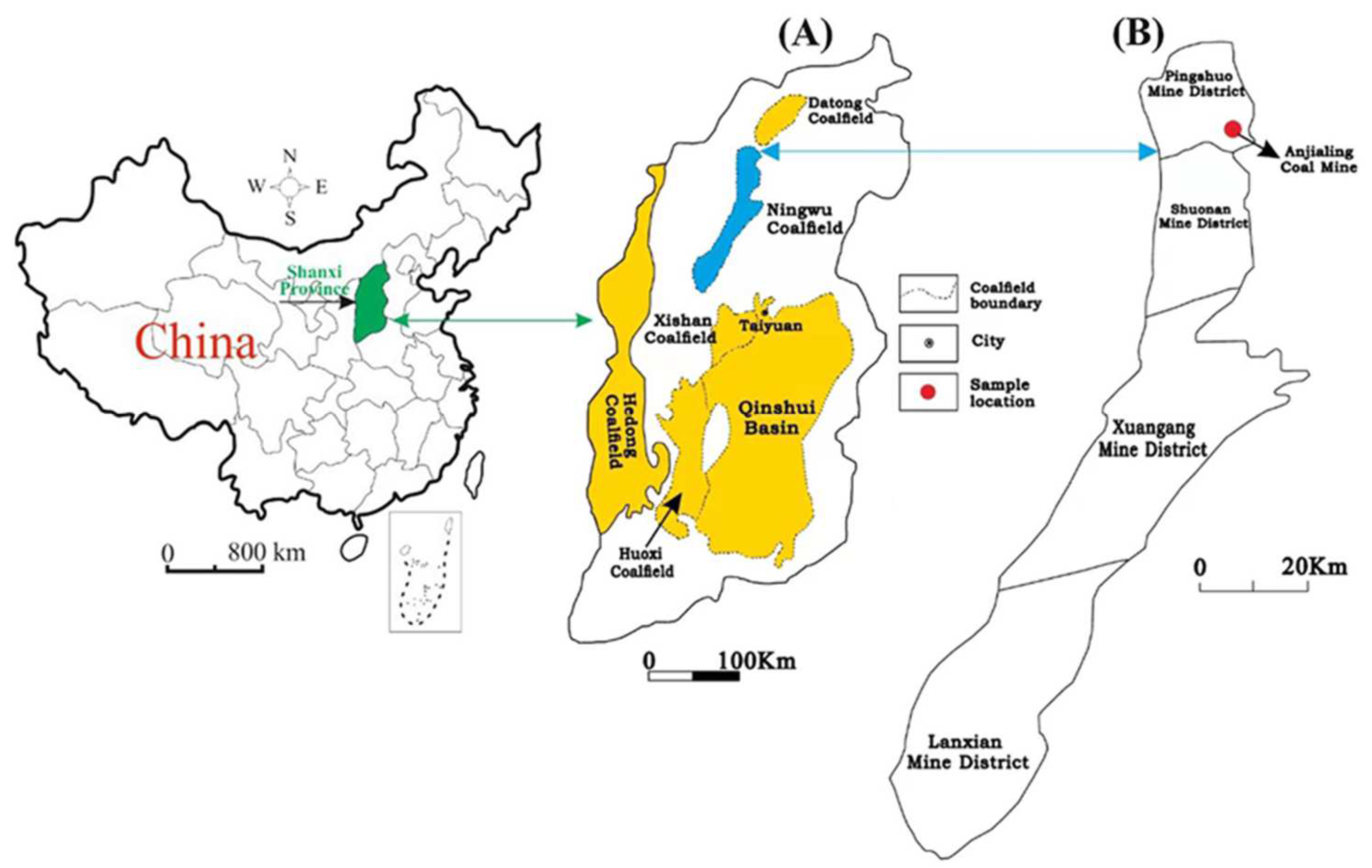

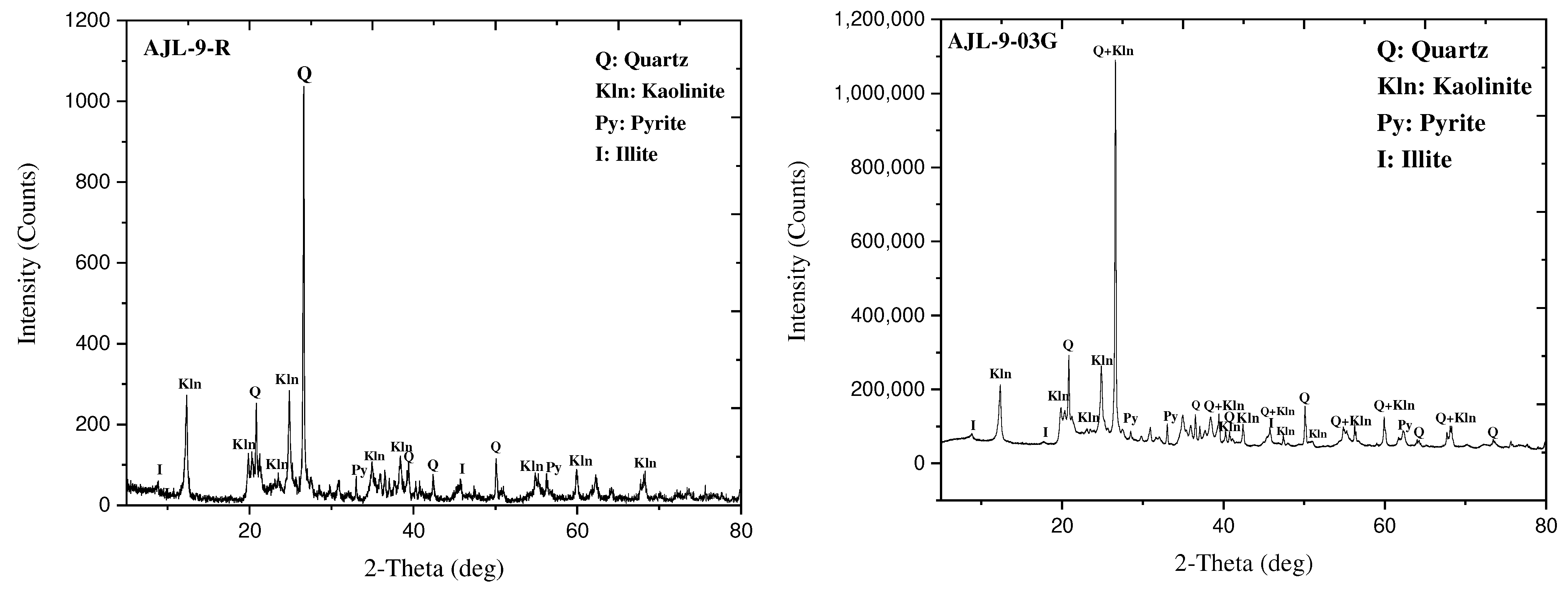
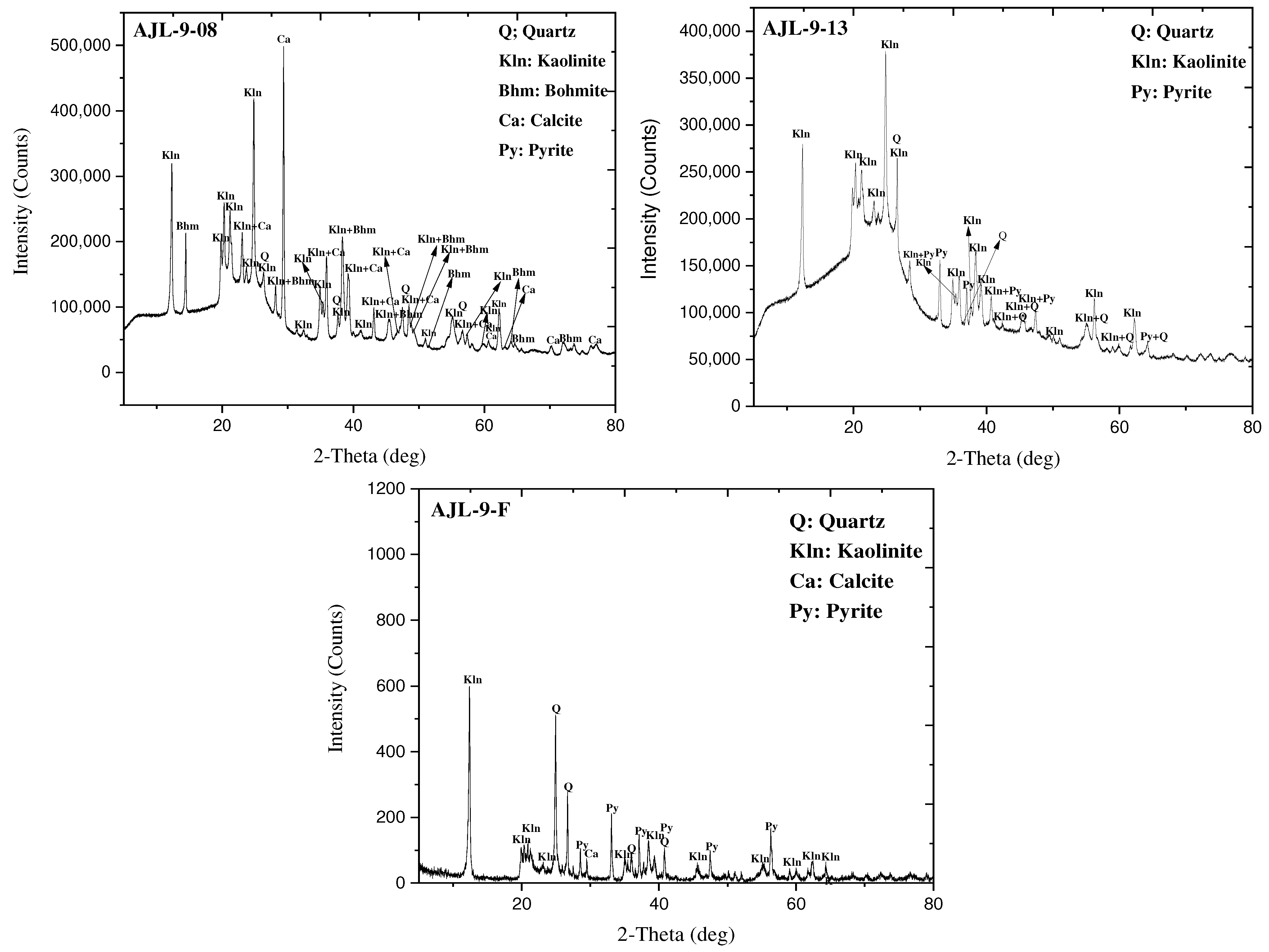
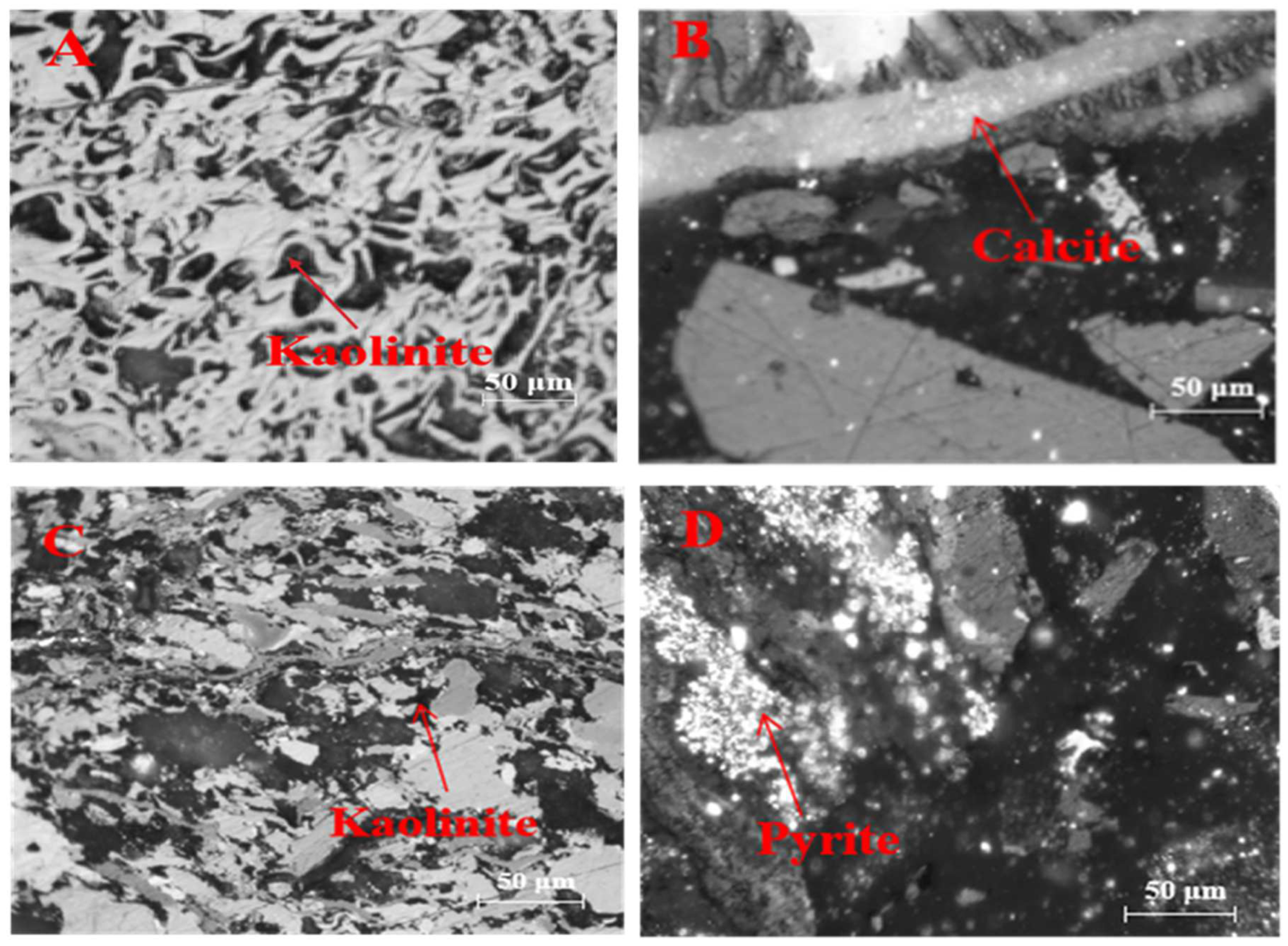
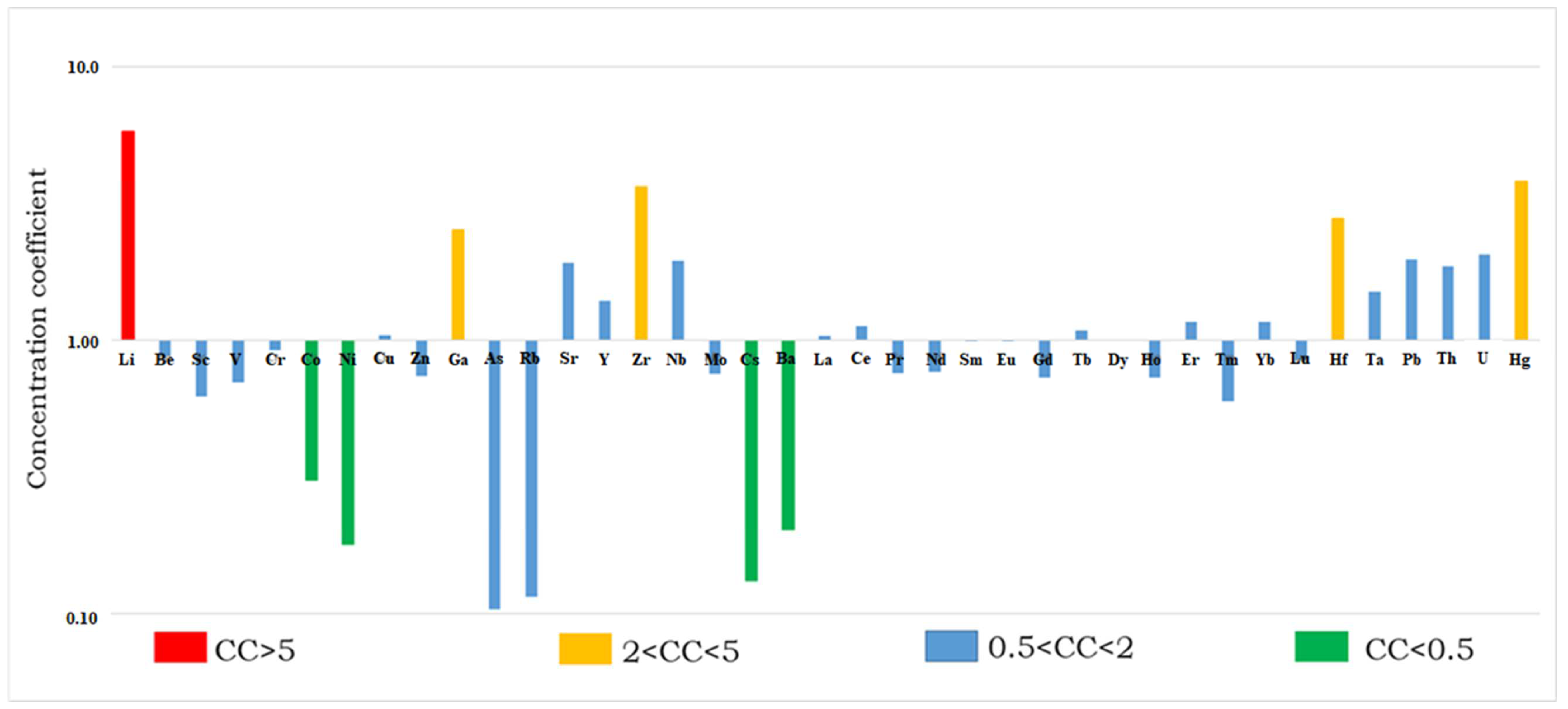
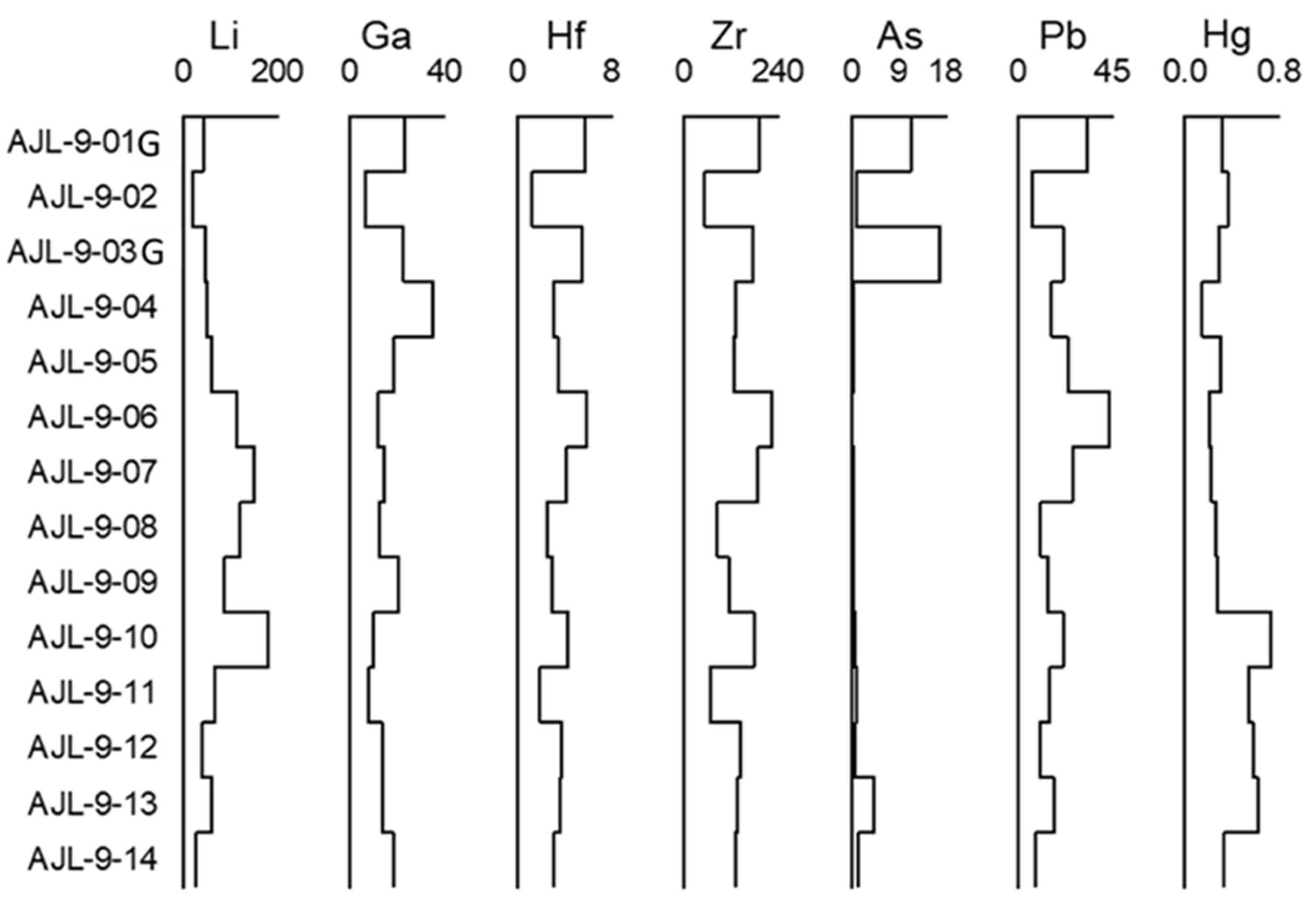
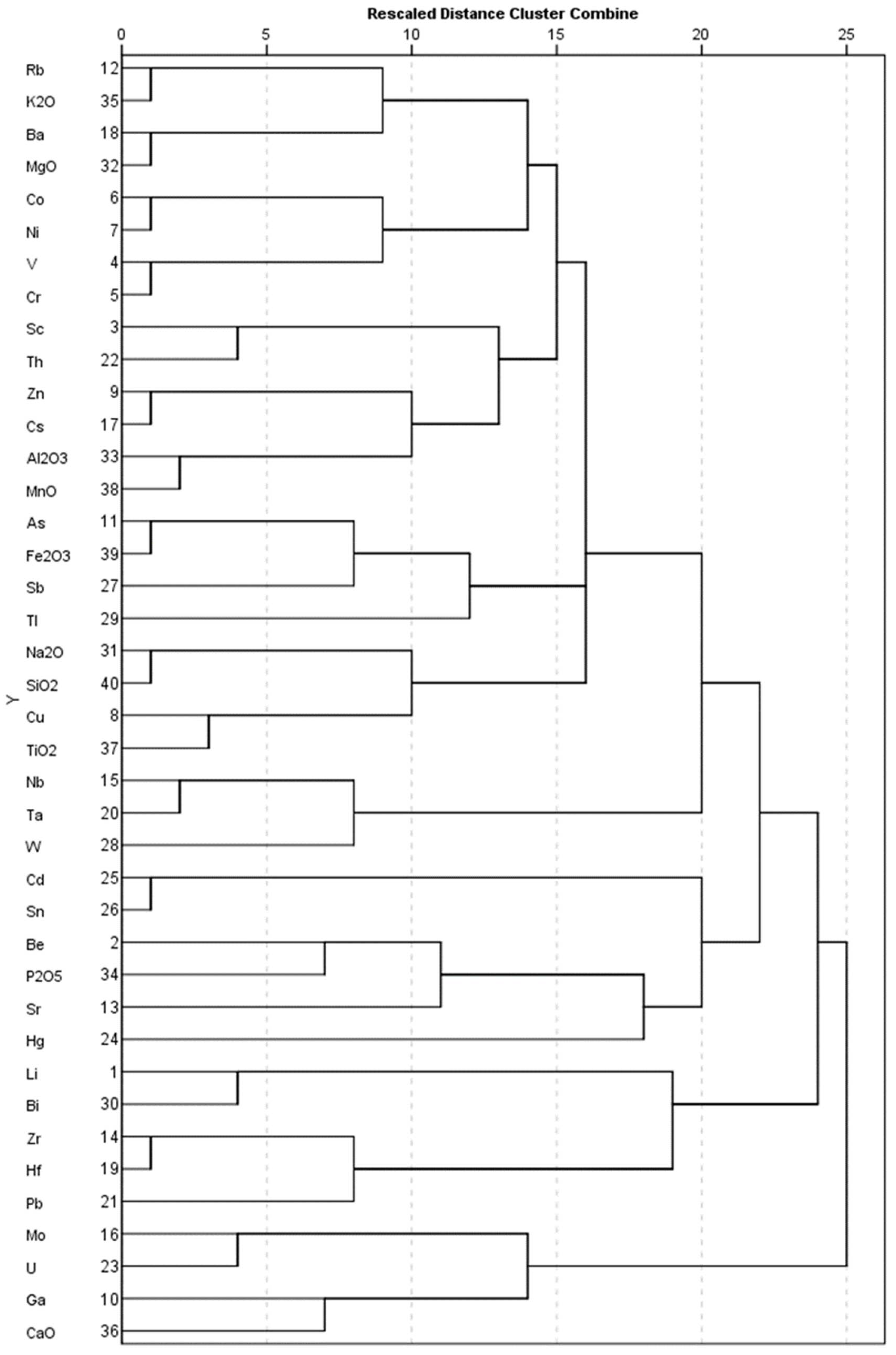
| Step | Modes of Occurrence | Method in Each Step |
|---|---|---|
| 1 | Water Soluble State | 1 g of coal sample + 1 mL of ethanol + 20 mL of water at normal temp. for 2 h, centrifuge for 30 min at 4000/r, and then |
| add 20 mL of water and centrifuge for 30 min at 4000/r | ||
| ↓ | ||
| 2 | Ion-Exchangeable Bound State | Residue + 20 mL 1 mol/L of CH3COONH4 at 40 °C for 2 h, centrifuge for 30 min at 4000/r, and then |
| add 20 mL of water and centrifuge for 30 min at 4000/r (three times) | ||
| ↓ | ||
| 3 | Carbonate Bound State | Residue + 20 mL 1 mol/L of CH3COOH at 40 °C for 2 h, centrifuge for 30 min at 4000/r, and then |
| add 20 mL of water and centrifuge for 30 min at 4000/r (three times) | ||
| ↓ | ||
| 4 | Sulfide Bound State | Residue + 20 mL 4 mol/L of HNO3 at 80 °C for 2 h, centrifuge for 30 min at 4000/r, and then |
| add 20 mL of water and centrifuge for 30 min at 4000/r (three times) | ||
| ↓ | ||
| 5 | Organic Bound State | Residue + 15 mL 0.02 mol/L of HNO3 + 5 mL of 30% H2O2 at 60 °C for 3 h, |
| add 5 mL of 30% H2O2 at 60 °C for 3 h, | ||
| add 5 mL 3.2 mol/L of CH3COONH4 at normal temp. for 3 h, centrifuge, and then | ||
| add 20 mL of water and centrifuge for 30 min at 4000/r (three times) | ||
| ↓ | ||
| 6 | Silicate Bound State | Residue |
| Sample | Type | Al2O3 | SiO2 | Na2O | MgO | P2O5 | K2O | CaO | TiO2 | MnO | Fe2O3 | SiO2/Al2O3 |
|---|---|---|---|---|---|---|---|---|---|---|---|---|
| AJL-9-R | Sandstone | 26.99 | 51.43 | 0.05 | 0.47 | 0.11 | 1.05 | 0.68 | 1.02 | 0.09 | 4.310 | 1.91 |
| AJL-9-01G | Gangue | 20.27 | 59.10 | 0.10 | 1.24 | 0.10 | 2.68 | 1.14 | 0.72 | 0.03 | 2.511 | 2.92 |
| AJL-9-02 | Coal | 2.44 | 6.11 | 0.004 | 0.06 | 0.008 | 0.012 | 1.5 | 0.17 | 0.008 | 0.279 | 2.50 |
| AJL-9-03G | Gangue | 21.21 | 56.18 | 0.07 | 1.06 | 0.14 | 2.13 | 0.88 | 0.73 | 0.03 | 3.208 | 2.65 |
| AJL-9-04 | Coal | 5.40 | 10.32 | 0.012 | 0.37 | 0.018 | 0.023 | 4.09 | 0.15 | 0.014 | 0.453 | 1.91 |
| AJL-9-05 | Coal | 5.42 | 9.56 | 0.008 | 0.12 | 0.012 | 0.02 | 1.04 | 0.28 | 0.002 | 0.315 | 1.76 |
| AJL-9-06 | Coal | 6.89 | 22.02 | 0.02 | 0.07 | 0.018 | 0.16 | 0.13 | 0.54 | 0.000 | 0.156 | 3.2 |
| AJL-9-07 | Coal | 6.96 | 22.32 | 0.024 | 0.10 | 0.03 | 0.2 | 0.38 | 0.34 | 0.001 | 0.188 | 3.21 |
| AJL-9-08 | Coal | 11.61 | 16.76 | 0.014 | 0.08 | 0.02 | 0.04 | 2.94 | 0.26 | 0.010 | 0.184 | 1.44 |
| AJL-9-09 | Coal | 5.42 | 9.73 | 0.006 | 0.06 | 0.03 | 0.024 | 2.05 | 0.22 | 0.005 | 0.102 | 1.8 |
| AJL-9-10 | Coal | 5.23 | 25.46 | 0.013 | 0.03 | 0.019 | 0.064 | 0.48 | 0.40 | 0.001 | 0.133 | 4.87 |
| AJL-9-11 | Coal | 4.18 | 8.13 | 0.005 | 0.04 | 0.013 | 0.025 | 0.49 | 0.18 | 0.001 | 0.745 | 1.95 |
| AJL-9-12 | Coal | 3.18 | 6.72 | 0.003 | 0.04 | 0.16 | 0.02 | 0.26 | 0.14 | 0.001 | 0.457 | 2.11 |
| AJL-9-13 | Coal | 4.11 | 11.55 | 0.004 | 0.04 | 0.02 | 0.05 | 0.18 | 0.32 | 0.001 | 1.531 | 2.81 |
| AJL-9-14 | Coal | 3.4 | 6.78 | 0.002 | 0.05 | 0.008 | 0.014 | 0.623 | 0.14 | 0.002 | 0.407 | 2.00 |
| AJL-9-F | Sandstone | 29.32 | 51.43 | 0.05 | 0.26 | 0.03 | 0.19 | 0.17 | 0.74 | 0.010 | 1.470 | 1.75 |
| AV-C | 5.35 | 12.96 | 0.01 | 0.09 | 0.03 | 0.05 | 1.18 | 0.26 | 0.000 | 0.410 | 2.42 | |
| AV-G | 20.74 | 57.64 | 0.08 | 1.15 | 0.123 | 2.40 | 1.009 | 0.73 | 0.03 | 2.859 | 2.78 | |
| AV-SST | 28.16 | 51.38 | 0.05 | 0.37 | 0.07 | 1.08 | 0.39 | 0.88 | 0.05 | 2.890 | 1.83 | |
| China a | 5.98 | 8.47 | 0.16 | 0.22 | 0.09 | 0.19 | 1.23 | 0.33 | 0.02 | 4.850 | 1.42 |
| Sample | AJL-9-R | AJL-9-01G | AJL- 9-02 | AJL- 9-03G | AJL- 9-04 | AJL- 9-05 | AJL- 9-06 | AJL- 9-07 | AJL- 9-08 | AJL- 9-09 | AJL- 9-10 | AJL- 9-11 | AJL- 9-12 | AJL- 9-13 | AJL- 9-14 | AJL-9-F | a World Coal | b Coal | AV-C | AV-G | CC |
|---|---|---|---|---|---|---|---|---|---|---|---|---|---|---|---|---|---|---|---|---|---|
| Li | 11.7 | 42.3 | 19.3 | 46.2 | 49.0 | 59.9 | 113 | 150 | 121 | 87.1 | 181 | 66.4 | 40.8 | 60.9 | 27.0 | 74.0 | 14.0 | 14.0 | 81.3 | 44.3 | 5.81 |
| Be | 1.41 | 2.84 | 3.61 | 3.01 | 1.48 | 1.51 | 1.05 | 1.11 | 1.17 | 1.21 | 1.17 | 1.47 | 3.36 | 1.94 | 1.95 | 1.68 | 2.00 | 2.00 | 1.75 | 2.93 | 0.88 |
| Sc | 8.64 | 7.62 | 2.62 | 7.32 | 6.03 | 1.81 | 0.59 | 0.74 | 3.23 | 3.37 | 0.23 | 0.83 | 1.23 | 1.04 | 5.87 | 5.65 | 3.70 | 49.0 | 2.30 | 7.47 | 0.62 |
| V | 94.9 | 115 | 37.7 | 156 | 25.5 | 14.0 | 29.6 | 23.7 | 8.60 | 15.7 | 15.1 | 7.09 | 13.8 | 26.0 | 18.7 | 28.2 | 28.0 | 21.0 | 19.6 | 135.5 | 0.70 |
| Cr | 47.0 | 62.0 | 27.6 | 78.7 | 21.0 | 10.0 | 14.9 | 11.6 | 11.0 | 13.5 | 9.58 | 7.93 | 14.1 | 24.6 | 21.4 | 13.5 | 17.0 | 12.0 | 15.6 | 70.4 | 0.92 |
| Co | 13.1 | 15.3 | 2.79 | 18.1 | 4.60 | 1.53 | 1.58 | 1.97 | 1.22 | 1.35 | 1.23 | 0.74 | 1.33 | 2.33 | 1.51 | 4.74 | 6.00 | 7.00 | 1.85 | 16.7 | 0.31 |
| Ni | 33.4 | 40.2 | 6.86 | 45.4 | 17.1 | 1.63 | 1.76 | 0.98 | 3.85 | 2.67 | 0.00 | 0.00 | 0.00 | 1.32 | 0.48 | 20.4 | 17.0 | 14.0 | 4.07 | 42.8 | 0.24 |
| Cu | 66.6 | 31.3 | 18.0 | 36.9 | 20.8 | 12.0 | 26.9 | 26.3 | 13.2 | 13.8 | 14.0 | 11.4 | 16.4 | 15.7 | 11.4 | 99.8 | 16.0 | 13.0 | 16.7 | 34.1 | 1.04 |
| Zn | 132 | 113 | 22.0 | 143 | 19.1 | 40.0 | 25.7 | 18.4 | 13.8 | 13.9 | 16.9 | 12.5 | 18.9 | 22.6 | 24.4 | 113 | 28.0 | 35.0 | 20.7 | 126 | 0.74 |
| Ga | 20.6 | 23.0 | 6.43 | 22.6 | 35.0 | 18.7 | 11.9 | 14.4 | 12.4 | 20.5 | 9.89 | 7.89 | 13.5 | 13.7 | 18.1 | 17.9 | 6.00 | 9.00 | 15.2 | 22.8 | 2.53 |
| As | 4.07 | 11.4 | 0.85 | 16.9 | 0.37 | 0.37 | 0.07 | 0.36 | 0.46 | 0.50 | 0.70 | 1.10 | 0.77 | 4.33 | 1.29 | 1.83 | 9.00 | 5.00 | 0.93 | 14.2 | 0.10 |
| Rb | 39.9 | 138 | 0.85 | 110 | 1.15 | 0.69 | 5.44 | 6.20 | 1.72 | 1.01 | 2.74 | 1.22 | 0.72 | 2.51 | 0.66 | 31.1 | 18.0 | 8.00 | 2.05 | 124 | 0.11 |
| Sr | 82.2 | 124 | 115 | 134 | 186 | 119 | 76.1 | 131 | 187 | 242 | 88.9 | 89.0 | 821 | 101 | 143 | 39.4 | 100 | 136 | 191.6 | 129 | 1.92 |
| Zr | 388 | 190 | 52.6 | 175 | 131 | 127 | 223 | 188 | 84.8 | 114 | 177 | 66.6 | 143 | 136 | 129 | 402 | 36.0 | 52.0 | 131 | 182.5 | 3.64 |
| Nb | 18.8 | 15.1 | 5.19 | 15.6 | 9.04 | 9.63 | 0.84 | 9.48 | 9.73 | 11.1 | 12.5 | 3.72 | 5.46 | 9.63 | 7.32 | 16.3 | 4.00 | 14.0 | 7.80 | 30.7 | 1.95 |
| Mo | 1.72 | 0.95 | 2.31 | 1.14 | 2.53 | 1.58 | 0.97 | 1.64 | 1.42 | 1.79 | 1.35 | 1.01 | 1.48 | 1.68 | 1.21 | 1.11 | 2.10 | 4.00 | 1.58 | 1.04 | 0.75 |
| Cs | 2.51 | 5.50 | 0.08 | 5.96 | 0.08 | 0.08 | 0.19 | 0.21 | 0.24 | 0.09 | 0.23 | 0.15 | 0.10 | 0.24 | 0.065 | 1.55 | 1.10 | 1.00 | 0.15 | 5.73 | 0.14 |
| Ba | 148 | 346 | 32.7 | 300 | 57.1 | 19.1 | 28.8 | 41.9 | 41.9 | 47.9 | 21.5 | 15.6 | 32.6 | 17.6 | 10.4 | 141 | 150 | 82.0 | 30.6 | 323 | 0.20 |
| Hf | 10.6 | 5.78 | 1.28 | 5.49 | 3.07 | 3.41 | 5.93 | 4.19 | 2.57 | 2.92 | 4.27 | 1.93 | 3.76 | 3.67 | 3.10 | 10.8 | 1.20 | 2.40 | 3.34 | 5.64 | 2.78 |
| Ta | 1.09 | 1.02 | 0.23 | 1.03 | 0.30 | 0.67 | 0.04 | 0.46 | 0.87 | 0.69 | 0.92 | 0.07 | 0.28 | 0.53 | 0.33 | 1.03 | 0.30 | 0.70 | 0.45 | 1.03 | 1.50 |
| Pb | 26.7 | 32.9 | 6.58 | 21.4 | 16.0 | 23.6 | 43.6 | 25.9 | 10.7 | 14.2 | 21.4 | 15.0 | 10.4 | 17.1 | 8.33 | 21.9 | 9.00 | 13.0 | 17.73 | 27.2 | 1.97 |
| Th | 13.6 | 17.2 | 5.48 | 17.7 | 6.16 | 7.37 | 3.35 | 3.88 | 10.8 | 7.53 | 1.86 | 6.01 | 5.37 | 6.94 | 6.50 | 5.41 | 3.20 | 6.00 | 5.94 | 17.5 | 1.86 |
| U | 4.00 | 3.30 | 5.96 | 3.62 | 7.97 | 4.39 | 2.96 | 3.83 | 3.12 | 3.70 | 2.09 | 1.68 | 2.76 | 3.96 | 4.51 | 1.47 | 1.90 | 3.00 | 3.91 | 3.46 | 2.06 |
| Ge | 2.02 | 1.01 | 2.40 | 0.99 | 0.42 | 0.14 | 0.23 | 0.24 | 0.17 | 0.13 | 0.67 | 0.69 | 1.27 | 0.78 | 2.40 | 2.78 | 0.56 | 2.21 | 0.23 | ||
| Cd | 14.3 | 53.9 | 175.6 | 40.2 | 40.3 | 43.2 | 7.76 | 91.8 | 28.2 | 17.6 | 66.9 | 77.2 | 24.4 | 18.3 | 0.20 | 0.20 | 42.5 | 94.9 | 212.4 | ||
| Sb | 0.43 | 0.17 | 1.31 | 0.53 | 0.38 | 0.24 | 0.32 | 0.32 | 0.30 | 0.32 | 0.25 | 0.27 | 0.35 | 0.18 | 1.00 | 2.00 | 0.30 | 0.87 | 0.30 | ||
| W | 1.26 | 0.73 | 1.46 | 0.94 | 1.09 | 0.06 | 0.81 | 1.82 | 1.15 | 0.92 | 0.14 | 0.79 | 0.72 | 0.98 | 0.99 | 2.00 | 0.85 | 1.36 | 0.86 | ||
| Tl | 0.53 | 0.31 | 0.37 | 0.04 | 0.04 | 0.07 | 0.05 | 0.06 | 0.03 | 0.04 | 0.23 | 0.06 | 0.54 | 0.11 | 0.58 | 0.40 | 0.13 | 0.45 | 0.22 | ||
| Bi | 0.39 | 0.29 | 0.38 | 0.31 | 0.23 | 0.51 | 0.60 | 0.48 | 0.43 | 0.45 | 0.27 | 0.27 | 0.27 | 0.18 | 1.10 | 0.80 | 0.36 | 0.39 | 0.33 | ||
| Hg | 0.31 | 0.36 | 0.29 | 0.15 | 0.31 | 0.21 | 0.23 | 0.27 | 0.28 | 0.73 | 0.54 | 0.58 | 0.62 | 0.33 | 0.10 | 0.15 | 0.38 | 0.30 | 3.80 |
| Li Proportion (%) | ||||||
|---|---|---|---|---|---|---|
| Sample | Silicate Form | Organic Form | Sulfide Form | Carbonate Form | Ion-Exchangeable Form | Water Soluble Form |
| AJL-9-7 | 74 | 2 | 11 | 4 | 0 | 9 |
| AJL-9-8 | 82 | 4 | 0 | 5 | 1 | 8 |
| AJL-9-10 | 82 | 5 | 1 | 4 | 1 | 9 |
| AJL-9-13 | 82 | 2 | 3 | 1 | 0 | 12 |
| Ga Proportion (%) | ||||||
| AJL-9-7 | 55 | 1 | 41 | 0 | 0 | 3 |
| AJL-9-8 | 94 | 2 | 0 | 1 | 0 | 3 |
| AJL-9-10 | 94 | 2 | 0 | 1 | 0 | 3 |
| AJL-9-13 | 57 | 4 | 39 | 0 | 0 | 0 |
| Zr Proportion (%) | ||||||
| AJL-9-7 | 47 | 17 | 37 | 0 | 0 | 0 |
| AJL-9-8 | 70 | 29 | 1 | 0 | 0 | 0 |
| AJL-9-10 | 66 | 34 | 0 | 0 | 0 | 0 |
| AJL-9-13 | 56 | 22 | 22 | 0 | 0 | 0 |
| As Proportion (%) | ||||||
| AJL-9-7 | 92 | 0 | 7 | 0 | 0 | 1 |
| AJL-9-8 | 98 | 0 | 0 | 0 | 0 | 2 |
| AJL-9-10 | 98 | 0 | 0 | 0 | 0 | 2 |
| AJL-9-13 | 35 | 2 | 62 | 0 | 0 | 2 |
| Pb Proportion (%) | ||||||
| AJL-9-7 | 3 | 1 | 86 | 8 | 1 | 0 |
| AJL-9-8 | 13 | 7 | 15 | 49 | 6 | 9 |
| AJL-9-10 | 11 | 5 | 8 | 63 | 10 | 2 |
| AJL-9-13 | 4 | 1 | 85 | 8 | 4 | 2 |
| Trace Element | SiO2 | Al2O3 | K2O | CaO | P2O5 | MgO | Na2O | TiO2 | MnO | Fe2O3 | Al2O3+ SiO2 |
|---|---|---|---|---|---|---|---|---|---|---|---|
| Li | 0.942 | 0.607 | 0.657 | −0.137 | −0.139 | −0.177 | 0.758 | 0.708 | −0.235 | −0.375 | −0.120 |
| Be | −0.636 | −0.652 | −0.462 | −0.133 | 0.486 | −0.165 | −0.613 | −0.542 | 0.074 | 0.196 | 0.084 |
| Sc | −0.484 | −0.021 | −0.479 | 0.705 | −0.201 | 0.582 | −0.290 | −0.614 | 0.679 | −0.113 | 0.690 |
| V | 0.024 | −0.326 | 0.275 | −0.014 | −0.228 | 0.217 | 0.160 | 0.199 | 0.174 | 0.066 | 0.773 |
| Cr | −0.429 | −0.473 | −0.251 | 0.144 | −0.139 | 0.191 | −0.365 | −0.280 | 0.338 | 0.392 | 0.682 |
| Co | −0.161 | −0.156 | −0.073 | 0.593 | −0.168 | 0.836 | 0.105 | −0.218 | 0.681 | 0.152 | 0.829 |
| Ni | −0.195 | 0.054 | −0.217 | 0.846 | −0.201 | 0.906 | 0.096 | −0.306 | 0.888 | −0.061 | 0.866 |
| Cu | 0.495 | 0.167 | 0.810 | −0.058 | 0.048 | 0.306 | 0.751 | 0.508 | −0.003 | −0.200 | 0.789 |
| Zn | −0.130 | −0.192 | −0.025 | −0.220 | −0.025 | 0.107 | −0.063 | 0.195 | −0.211 | 0.036 | 0.939 |
| Ga | −0.186 | 0.062 | −0.171 | 0.657 | −0.032 | 0.857 | 0.062 | −0.282 | 0.520 | −0.032 | 0.324 |
| As | −0.228 | −0.330 | −0.204 | −0.312 | −0.070 | −0.282 | −0.435 | −0.051 | −0.233 | 0.926 | 0.675 |
| Rb | 0.813 | 0.381 | 0.989 | −0.367 | −0.139 | −0.085 | 0.867 | 0.786 | −0.372 | −0.140 | 0.803 |
| Sr | −0.343 | −0.205 | −0.245 | −0.050 | 0.977 | −0.067 | −0.304 | −0.411 | −0.063 | −0.037 | −0.316 |
| Zr | 0.702 | 0.163 | 0.742 | −0.390 | 0.142 | 0.025 | 0.638 | 0.729 | −0.473 | −0.176 | 0.763 |
| Nb | 0.200 | 0.223 | −0.167 | 0.320 | −0.135 | 0.138 | 0.044 | −0.080 | 0.209 | −0.038 | 0.799 |
| Mo | −0.315 | −0.193 | −0.289 | 0.656 | −0.053 | 0.658 | −0.082 | −0.420 | 0.738 | 0.020 | −0.405 |
| Cs | 0.757 | 0.567 | 0.550 | −0.241 | −0.128 | −0.313 | 0.540 | 0.657 | −0.229 | 0.208 | 0.833 |
| Ba | 0.111 | 0.397 | 0.149 | 0.736 | 0.155 | 0.628 | 0.418 | −0.113 | 0.684 | −0.395 | 0.855 |
| Hf | 0.679 | 0.227 | 0.696 | −0.414 | 0.168 | −0.049 | 0.587 | 0.786 | −0.504 | −0.121 | 0.830 |
| Ta | 0.354 | 0.461 | −0.118 | 0.228 | −0.109 | −0.112 | 0.108 | 0.139 | 0.125 | −0.187 | 0.775 |
| Pb | 0.682 | 0.296 | 0.768 | −0.335 | −0.179 | 0.038 | 0.711 | 0.884 | −0.410 | −0.178 | 0.505 |
| Th | −0.488 | 0.394 | −0.503 | 0.526 | −0.078 | 0.108 | −0.345 | −0.459 | 0.470 | 0.171 | 0.659 |
| U | −0.360 | −0.179 | −0.234 | 0.648 | −0.240 | 0.795 | −0.051 | −0.384 | 0.720 | 0.016 | −0.308 |
| Ge | −0.662 | −0.591 | −0.495 | 0.092 | 0.011 | 0.233 | −0.593 | −0.541 | 0.253 | 0.753 | 0.234 |
| Cd | −0.318 | 0.275 | −0.370 | 0.278 | 0.377 | −0.044 | −0.230 | −0.298 | 0.329 | −0.037 | 0.011 |
| Sb | 0.150 | 0.303 | −0.026 | 0.572 | −0.036 | 0.772 | 0.291 | 0.023 | 0.446 | 0.136 | 0.196 |
| Tl | −0.299 | −0.399 | −0.181 | −0.288 | −0.209 | −0.282 | −0.414 | −0.059 | −0.121 | 0.850 | 0.150 |
| Bi | 0.835 | 0.674 | 0.807 | 0.029 | −0.075 | −0.036 | 0.882 | 0.649 | −0.028 | −0.494 | −0.284 |
| Hg | 0.025 | −0.412 | −0.256 | −0.547 | 0.290 | −0.586 | −0.418 | 0.021 | −0.488 | 0.447 | −0.508 |
Publisher’s Note: MDPI stays neutral with regard to jurisdictional claims in published maps and institutional affiliations. |
© 2022 by the authors. Licensee MDPI, Basel, Switzerland. This article is an open access article distributed under the terms and conditions of the Creative Commons Attribution (CC BY) license (https://creativecommons.org/licenses/by/4.0/).
Share and Cite
Ikeh, T.J.; Sun, B.; Liu, C.; Liu, Y.; Kong, Y.; Pan, X. Modes of Occurrence and Enrichment of Trace Elements in Coal from the Anjialing Mine, Pingshuo Mining District, Ningwu Coalfield, Shanxi Province, China. Minerals 2022, 12, 1082. https://doi.org/10.3390/min12091082
Ikeh TJ, Sun B, Liu C, Liu Y, Kong Y, Pan X. Modes of Occurrence and Enrichment of Trace Elements in Coal from the Anjialing Mine, Pingshuo Mining District, Ningwu Coalfield, Shanxi Province, China. Minerals. 2022; 12(9):1082. https://doi.org/10.3390/min12091082
Chicago/Turabian StyleIkeh, Tobechukwu Justin, Beilei Sun, Chao Liu, Yunxia Liu, Yanlei Kong, and Xinyu Pan. 2022. "Modes of Occurrence and Enrichment of Trace Elements in Coal from the Anjialing Mine, Pingshuo Mining District, Ningwu Coalfield, Shanxi Province, China" Minerals 12, no. 9: 1082. https://doi.org/10.3390/min12091082





